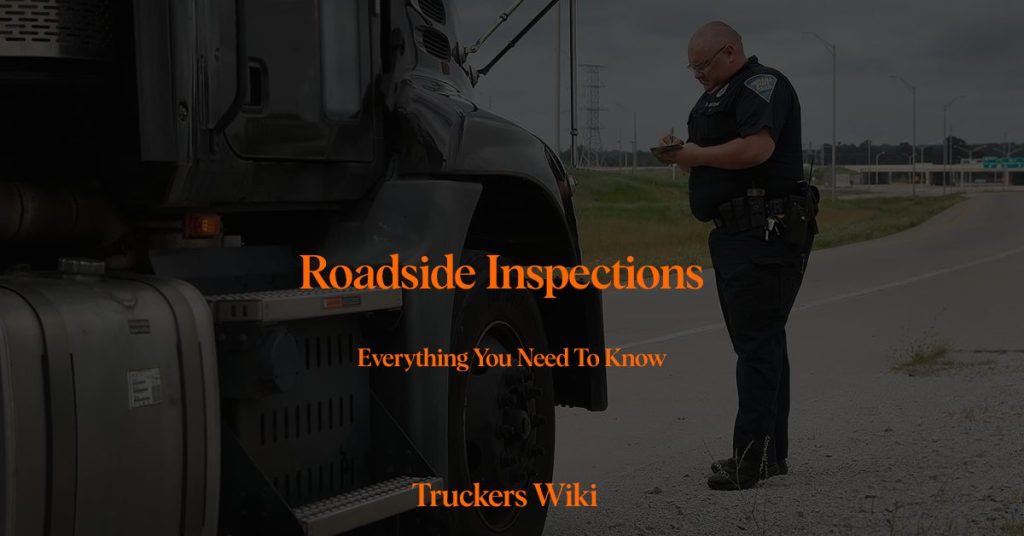
Table of Contents
What are Roadside Inspections (D.O.T. Inspection)
Roadside or DOT inspections are examinations of individual commercial vehicles and drivers conducted by law enforcement personnel. These inspections are aimed at identifying any violations of safety regulations set by the FMCSA. Depending on the severity of the violation, the officer may put the vehicle or driver out of service until the issue is rectified.
Common elements reviewed during an inspection include the driver’s license, hours-of-service documentation, motor carrier registration, shipping papers, seat belt usage, and the condition of the vehicle’s components and equipment.
Levels of Roadside Inspections
There are six levels of roadside inspections. Each level represents a specific set of checks:
Level I: Full Inspection
- Check for all required driver documents, including a commercial driver’s license (CDL), medical certificate, record of duty status, and vehicle inspection report.
- Review hours-of-service compliance.
- Inspect seat belt usage.
- Examine the vehicle for any noticeable leaks or other issues.
- Conduct a detailed inspection of the vehicle’s components, including the brake system, coupling devices, exhaust system, frame, fuel system, lights, steering mechanism, suspension, tires, wheels and rims, and windshield wipers, among others.
- Look for any issues related to safe loading.
Level II: Walk-Around Inspection
- Review all driver-related items as in Level I.
- Conduct an external inspection of the vehicle, which involves a walk-around. The inspector will not go under the vehicle during a Level II inspection.
The driver inspection is identical to Level I.
Level III: Driver-Only Inspection – This inspection includes only items related to the driver such as the license, logs, medical certificate, hours of service, seat belt, and hazardous materials if applicable.
- Review all driver-related items, similar to Levels I and II.
- The vehicle is not inspected during a Level III check.
Level IV: Special Inspection – These are one-time examinations conducted to validate a particular study or to verify or refute a suspected trend.
Level V: Vehicle-Only Inspection – This involves an inspection of the vehicle without the driver present.
- Review all vehicle-related items as in Level I.
- This inspection is conducted without the driver present.
Level VI: Enhanced Inspection for Transuranic Waste and Highway Route Controlled Quantities (HRCQ) of Radioactive Materia – This level specifically applies to certain radioactive shipments. It includes inspecting for radiological shipments, enhanced out-of-service criteria, and checking for compliance with the North American Standard Out-of-Service Criteria.
- Review radiological requirements.
- Inspect emergency response information, shipping paper and package certification, and package condition, and conduct other radiological checks.
Tips for Drivers During a Roadside Inspection
Facing a roadside inspection can be daunting for drivers, but here are some tips to help the process go more smoothly:
Stay Calm and Be Respectful: Treat the inspector with respect and remain calm. This professional demeanor can help the process proceed smoothly.
Have Your Paperwork Ready: Have your driver’s license, medical certificate, vehicle registration, proof of periodic inspections, and record of duty status readily accessible.
Know Your Pre-Trip: Be familiar with all the steps involved in a pre-trip inspection. This knowledge may be useful during the inspection.
Keep Your Cab Clean: A clean and organized cab can make a positive impression on the inspector.
Fix Any Violations Promptly: If the inspector finds any violations, make sure they’re corrected as soon as possible.
Learn about the Most Common DOT Violations here.
Learn about DOT Compliance here.
Here is a full DOT Compliance Check List.
FMCSA on roadside inspections.
Listen to The Article Here
DOT Inspector explains what he looks for when checking semis video by Steven Welch
Last modified: February 13, 2024

